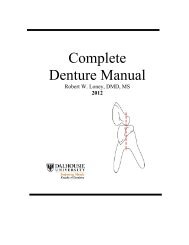RPD Manual 11 - Removable Prosthodontics - Dalhousie University
RPD Manual 11 - Removable Prosthodontics - Dalhousie University
RPD Manual 11 - Removable Prosthodontics - Dalhousie University
Create successful ePaper yourself
Turn your PDF publications into a flip-book with our unique Google optimized e-Paper software.
Framework Adjustment - 88<br />
after adjustment will be subject to fatigue and possible fracture. The latter situation may<br />
occur due to inadequate preparation (i.e. not considering opposing occlusion) or<br />
subsequent extrusion of teeth. If the teeth have extruded, the entire framework will most<br />
likely not fit. If occlusal interferences exist that will excessively thin the rests, the rest<br />
seat preparation may have to be deepened and a new impression taken, or an opposing<br />
cusp or framework<br />
element may have to be reduced. Reduction of opposing cusps should be performed as a<br />
last resort to save an otherwise acceptable framework.<br />
Occlusal interferences should not normally occur on retentive clasp arms if proper<br />
treatment planning has been followed. However, if the opposing occlusion is not<br />
considered at the time of mouth preparations, it is possible that occlusal contact may occur<br />
on a retentive arm. If this contact is minor, the opposing cusp may be reduced. Again,<br />
reduction of opposing cusps should be performed as a last resort to save an otherwise<br />
acceptable framework. If the interference is gross, the tooth surface should be recontoured<br />
(i.e. lower height of contour) and a new impression taken. IN NO INSTANCE SHOULD<br />
A RETENTIVE ARM BE RELIEVED, since this will affect its flexibility and resistance<br />
to fracture.<br />
Special Adjustments for Distal Extension Cases:<br />
In most cases distal extension cases will be designed with relatively short occluso-gingival<br />
guiding planes to allow for release of the abutments during tissueward movement of the<br />
denture base. However, there are some cases where teeth are tipped and a long guiding<br />
plane is the only type of guiding plane that can be placed. In these instances, "physiologic<br />
relief" of the framework should be used to provide release. With this technique the distal<br />
guiding planes, minor connectors and linguoplates are coated with alcohol and rouge (not<br />
wax or silicone). The framework is placed intraorally and placed under hyperfunction by<br />
pressing over the distal extension gridwork. The framework is removed and the<br />
guideplanes and other rigid metal contacts, which could torque the tooth, are relieved in<br />
areas of burn-through. Relief should be provided so that marks remain in only the<br />
occlusal one third of the guiding planes.<br />
Finishing and Polishing of Adjusted Surfaces<br />
All adjusted surfaces should be smoothed and brought to a high polish. This is imperative,<br />
since even well finished frameworks have been shown to enhance intraoral plaque<br />
adhesion. Dedco green knife-edge wheels for chrome cobalt alloys will remove scratches<br />
and bring the adjusted surface to a high shine quickly. Additionally, Dedco blue clasp<br />
polishers or any other carborundum-impregnated points can be used to finish the chrome<br />
cobalt alloy. A final polish can be placed using a tripoli on a bristle brush and rouge on a<br />
small diameter cloth wheel. Use care not to snag the cloth wheel on sharp edges of the<br />
framework (to prevent injury to yourself). Remove traces of the polishing compounds<br />
with soap and water and a toothbrush.















